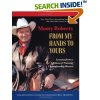CORRECT LUNGING by Valerie Netto
 |
Find a suitable area for lunging. If you have access to a round pen your first sessions will be much easier. An enclosed area is best in case you should lose control of the horse. Flat ground is important. A fence or barrier of some sort can come in handy in some situations.
PREPARE!
Decide the direction you will teach first and stick to it. I am going to start out going to the left. I will keep all of my body positions the same. Going to the left I will always hold the lead in my left hand, the whip or excess of the line in my right hand. I will always switch hands when I switch directions. I will point to the left, leading the horses nose to the left, start moving my feet and lifting the whip or swinging the rope end toward the horses hip to indicate forward motion. I will keep the whip low and move my feet at a quiet steady pace to show the horse that my intent is for him to follow my body quietly at the walk.
If my feet are moving his feet need to be moving. I will position my body off behind his whither to avoid inadvertently causing him to stop. I will keep my eyes relaxed and not staring at his face. A fixed stare at horse's eye can unsettle him. It can be perceived as a challenge and lack of confidence to a bold horse and a threat to a timid one. I will keep steady with the whip low and back with my feet moving.
If the horse stops I will keep my feet moving and bring the whip forward toward the hind legs to remind him to keep going until I stop my feet. The feet's moving is the most natural way to communicate "moving" on to a horse. It is what propels all legged creatures. In a herd a horse does not wait for the leader to yell, "let's go!" he sees the leader move off. The rate of speed desired is also noted in the body position and feet movement. Because this is so natural a horse can easily see your intent. Now you may add voice commands.
When your body is communicating well it is easy for the horse to make the association between body and voice. This makes the transition to the saddle easier to understand. All the while you are teaching yourself body control. Your body control will aid the horse in his way of going and transitions while mounted. Body control works as a preparatory command. Preparatory commands allow the horse a chance to prepare. This in turn will build confidence in the horse that you are a trustworthy leader.
To stop, simply stop all forms of communication. Stop your feet. Lower your head, exhale and softly say "whoa". Remember your horse is supposed to be responding to you. If you would like a smooth relaxed stop, act like it!!
The most certain way to make a great horse is to be a great leader. Don't expect a calm secure and willing horse to come from a loud and rowdy training session. Even a speed event horse needs to be calm minded enough to nail a pattern. And obedient enough to stop when it is over!
I will keep my horse on the circle. Not on an oval. If the horse fades out I will pull and release his nose until he comes in. If he leaks in I will point the whip or swing the rope at the shoulder until he moves back out. I will do this consistently until he stays on the circle. Once he becomes steady for several strides I will stop him and pet him. Once you are both good at starts, stops and walking a nice round circle change directions.
Repeat the process above.
When you and the horse are good at the walk you may add the trot, then the canter.
To trot, raise the whip a couple of feet higher. Elevate your shoulders and walk with more energy. If the horse does not respond by trotting, cluck to him, if that does not work become more aggressive by cracking the whip. Once in the trot keep your body and whip position keeping the energy in your body. The horse will keep trotting until you drop your arm/whip position and slow your energy. For the canter raise the whip a bit higher than for the trot and kiss to the horse. Keep a steady cadence in your body rhythm.
Again remember that while using your body on the ground you are building muscle memory, or habit into your system that will go to the saddle with you to create steadiness in your horse.
Again the point to lunging is to set up pecking order, train for obedience and correctness. Lunging is the best tool a trainer can have if done correctly. I hope you will take the time to learn and teach it correctly.
NEVER UNDERESTIMATE THE EFFECTIVENESS OF THE "LITTLE" THINGS.
A valuable work of art is made with thousands of tiny, well placed brush strokes!
-Valerie Netto









.jpg)


